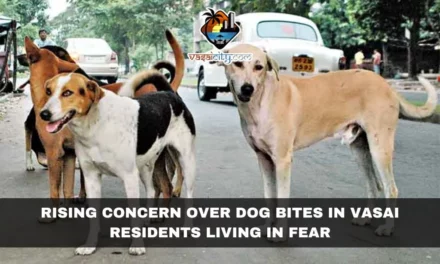The coastal belt of Vasai, home to several serene villages like Bhuigaon, Arnala, Navapur, and Rangaon, is in distress. As the monsoon sweeps in with stronger sea currents, the villagers find themselves battling the wrath of nature – and the slowness of bureaucracy. Their homes, farmland, trees, and sources of drinking water are now under serious threat from rising sea levels and erosion. Despite approvals in principle, the actual construction of vital anti-erosion embankments remains in limbo.
For years, these coastal communities have witnessed a gradual but dangerous change. Each monsoon season, the waves crash harder, reach farther inland, and destroy more than just sand. With every passing year, the fear deepens – will the next storm wash away their homes?
“We Just Want to Feel Safe in Our Homes”
Villagers from these areas have been reaching out to officials, writing letters, and following up with state agencies to get the promised embankments built. These embankments, once constructed, would act as barriers to protect the shore from the violent push of the tides, especially during monsoon.
Unfortunately, the Maharashtra State Road Development Corporation (MSRDC), the agency responsible for building the embankments, says they are yet to receive the necessary permissions from multiple government bodies. The most critical of these is the Coastal Regulation Zone (CRZ) clearance — without which no work can begin.
“We are not asking for anything new. The plans are already approved. The government knows we need protection from the sea. Why the delay then?” asked a resident of Rangaon, whose house now sits dangerously close to the waterline.
Bureaucratic Delays Hold Up Critical Work
Joy Joseph Fargose, Secretary of the Aam Aadmi Party (AAP) in Vasai, has taken a strong stand on the issue. Speaking to us, he said, “Work on a protective coastal embankment at Bhuigaon was planned. But the CRZ clearance is still pending. MSRDC has clearly stated this in a letter they sent me on July 1.”
This delay is more than just paperwork. According to Joy, every season wasted without embankment protection leads to more destruction — not just of property, but also of natural defenses like Casuarina tree plantations, especially around the Suruchi Baug area. “These trees form the first line of protection. Many have already been uprooted. When they are gone, the villages are left exposed,” he explained.
The letter from MSRDC confirms that without the CRZ permission, the contractor cannot be authorized to begin work. Until then, no embankment construction can be initiated, despite the urgency.
Casuarina Trees: Nature’s Wall is Falling Apart
One of the worst-hit areas is the Suruchi Baug Casuarina plantation. These tall, hardy trees — locally known as ‘suru’ — have historically acted as a buffer between the sea and the land. Their roots help hold the soil together and reduce erosion. But now, many of these trees lie uprooted on the beach, unable to withstand the strong tidal forces.
“The Casuarina trees were our natural shield,” said a farmer from Navapur. “But one by one, they are falling. Some are lying dead on the shore, some are being dragged into the sea. It’s heartbreaking.”
Locals worry that these dead trees, apart from being a loss to biodiversity, are becoming a hazard. Tourists visiting the beaches may trip over them, and those washed away into the sea can damage marine ecosystems.
Water Sources and Farmlands at Risk
The consequences of sea erosion aren’t limited to tree loss. Many families in these villages rely on wells and small water bodies for their daily needs. With the sea breaching further inland, salty seawater is beginning to mix with fresh water sources, making it unsafe to drink.
“Our well water now tastes salty. We can’t use it for drinking or cooking anymore,” said a mother of three from Arnala. “We’ve started buying water cans, which we never needed before.”
Farming, too, has taken a big hit. With sea water encroaching on agricultural land, the soil has turned saline in many places — rendering it unfit for cultivation. For a community heavily reliant on farming and fishing, this is a blow to their already fragile livelihoods.
“We Need Action, Not Promises”
Joy Joseph Fargose believes the situation is avoidable — if only the different departments and agencies involved could work together. “This is not about politics. This is about people’s lives. All the departments need to sit at one table and resolve this. We don’t have time to waste,” he urged.
He added that such a critical infrastructure project should not be left hanging in the balance due to procedural delays. “We are not building a mall. We are trying to protect people’s homes and livelihoods. This embankment is a basic need for the coastal people of Vasai.”
Villagers have also expressed frustration that despite repeated news coverage and official visits in the past, the matter hasn’t moved forward. “Every year, someone from the government comes, takes photos, and leaves. Then the files just sit on some desk,” said a local schoolteacher from Bhuigaon.
The Road Ahead
With the monsoon in full swing and tides rising daily, there’s a sense of urgency and helplessness. Locals continue to live with uncertainty — will the sea stop at their doorstep, or will it take more this time?
Activists and locals are now considering peaceful demonstrations and petitions to bring attention to the issue. “If we don’t act now, it may be too late next year,” Joy concluded.
As the rains continue to lash the coast, the waves carry with them more than just water — they bring erosion, anxiety, and a desperate call for action. Vasai’s coastal villages are no longer just asking for help — they’re demanding it.









